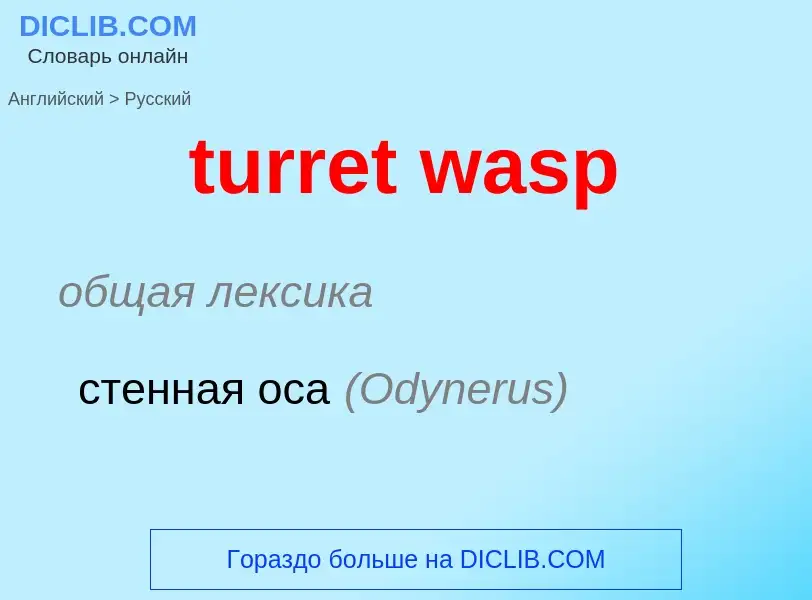Перевод и анализ слов искусственным интеллектом ChatGPT
На этой странице Вы можете получить подробный анализ слова или словосочетания, произведенный с помощью лучшей на сегодняшний день технологии искусственного интеллекта:
- как употребляется слово
- частота употребления
- используется оно чаще в устной или письменной речи
- варианты перевода слова
- примеры употребления (несколько фраз с переводом)
- этимология
turret wasp - перевод на русский
общая лексика
стенная оса (Odynerus)
[wɔsps]
общая лексика
"Уоспс" (регбийный клуб; находится в графстве Мидлсекс. Основан в 1867)
дословная передача
осы
[wɔsp]
общая лексика
оса (Vespa)
настоящие [складчатокрылые] осы (Vespidae)
роющие осы (Sphecidae)
Смотрите также
существительное
общая лексика
оса
зоология
оса (Vespoidae)
Определение
Википедия

In electronics, turret boards were an early attempt at making circuits that were relatively rugged, producible, and serviceable in the days before printed circuit boards (PCBs). As this method was somewhat more expensive than conventional "point-to-point" wiring techniques, it was generally found in the more expensive components, such as professional, commercial, and military audio and test equipment. This is similar to cordwood construction.
Turret boards consist of a thin (generally 1/8 inch) piece of insulating material drilled in pattern to match the electronic layout of a set of components. Each hole drilled will have a metal post (the turret) positioned in it. Electronic components are suspended between these turrets and soldered to them to create a complete circuit layout.
Most of the military electronics used in WWII made use of this construction method, and Altec professional gear of similar vintage has the same construction. However, the underside of some turret boards, such as a consumer Zenith 1A10 console radio, circa 1940, consists of an array of electronics components that are simply suspended, rather than tethered or soldered down, and thus could move unexpectedly. Such construction methods tended to keep the neighborhood radio repairman in work. In general, however, the use of turrets and turret boards dramatically improved reliability and serviceability.
Turret boards additionally allowed some degree of "engineered" construction. That is, an engineer could design a turret board with listed component interconnects such that it could be assembled by someone skilled in component recognition and soldering. A schematic was unnecessary for assembly.
Until reliable high-temperature printed circuit boards were developed, turret board construction was considered the best available technology. Currently, the use of turret boards is limited to hand-wired vacuum tube electronics (be it commercial or hobby), often as an attempt to replicate a classic design or design approach. Popular DIY components utilizing this approach include reproduction vintage guitar amplifiers and certain professional studio components from the 1960s, such as the classic and still widely used Teletronix LA2A tube compressor. In general, however, due to the expense and time-consuming nature of turret board construction methods, experimental or test-stage electronics projects generally make use of one of the many types of perfboard available, while final circuits—both hobby and commercial—utilize printed circuit boards.






.jpg?width=200)
![1880}}, one of nine [[Royal Navy]] warships to bear the name 1880}}, one of nine [[Royal Navy]] warships to bear the name](https://commons.wikimedia.org/wiki/Special:FilePath/HMS Wasp (1880).jpg?width=200)
![''[[Polistes]]'' sp., India ''[[Polistes]]'' sp., India](https://commons.wikimedia.org/wiki/Special:FilePath/Indian yellow wasp.jpg?width=200)
![Male ''[[Electrostephanus petiolatus]]'' fossil from the [[Middle Eocene]], preserved in [[Baltic amber]] Male ''[[Electrostephanus petiolatus]]'' fossil from the [[Middle Eocene]], preserved in [[Baltic amber]]](https://commons.wikimedia.org/wiki/Special:FilePath/Neotype male of Electrostephanus petiolatus Brues in Baltic amber (AMNH B-JWJ-260).png?width=200)
![[[Wasp waist]], c. 1900, demonstrated by [[Polaire]], a French actress famous for this [[silhouette]] [[Wasp waist]], c. 1900, demonstrated by [[Polaire]], a French actress famous for this [[silhouette]]](https://commons.wikimedia.org/wiki/Special:FilePath/Polaire, French actress 5.jpg?width=200)
![European hornet, ''[[Vespa crabro]]'' European hornet, ''[[Vespa crabro]]''](https://commons.wikimedia.org/wiki/Special:FilePath/Vespa crabro09(js), Lodz(Poland).jpg?width=200)
![Bembix oculata]]'' ([[Crabronidae]]) feeding on a fly after paralysing it with its sting Bembix oculata]]'' ([[Crabronidae]]) feeding on a fly after paralysing it with its sting](https://commons.wikimedia.org/wiki/Special:FilePath/Wasp August 2007-23.jpg?width=200)

![''[[Megarhyssa macrurus]]'', a parasitoid. The body of a female is 50mm long, with a c. 100mm ovipositor ''[[Megarhyssa macrurus]]'', a parasitoid. The body of a female is 50mm long, with a c. 100mm ovipositor](https://commons.wikimedia.org/wiki/Special:FilePath/Ichneumon_wasp_(Megarhyssa_macrurus_lunato)_(7686081848).jpg?width=200)
![mutualistic]]. mutualistic]].](https://commons.wikimedia.org/wiki/Special:FilePath/CSIRO ScienceImage 11188 Fig wasp.jpg?width=200)
![Latina rugosa]]'' planidia (arrows, magnified) attached to an ant larva; the [[Eucharitidae]] are among the few parasitoids able to overcome the strong defences of ants. Latina rugosa]]'' planidia (arrows, magnified) attached to an ant larva; the [[Eucharitidae]] are among the few parasitoids able to overcome the strong defences of ants.](https://commons.wikimedia.org/wiki/Special:FilePath/Latina rugosa planidia.png?width=200)
![The [[Chrysididae]], such as this ''[[Hedychrum rutilans]]'', are known as cuckoo or jewel wasps for their parasitic behaviour and metallic [[iridescence]]. The [[Chrysididae]], such as this ''[[Hedychrum rutilans]]'', are known as cuckoo or jewel wasps for their parasitic behaviour and metallic [[iridescence]].](https://commons.wikimedia.org/wiki/Special:FilePath/Goudwesp.jpg?width=200)
![provisioning]] her nest with a honeybee provisioning]] her nest with a honeybee](https://commons.wikimedia.org/wiki/Special:FilePath/Bee wolf.jpg?width=200)
![Batesian mimic]] of wasps. Batesian mimic]] of wasps.](https://commons.wikimedia.org/wiki/Special:FilePath/Clytus arietis (Linné, 1758) (3989861203).jpg?width=200)
![Bee-eaters such as ''[[Merops apiaster]]'' specialise in feeding on bees and wasps. Bee-eaters such as ''[[Merops apiaster]]'' specialise in feeding on bees and wasps.](https://commons.wikimedia.org/wiki/Special:FilePath/Pair of Merops apiaster feeding detail.jpg?width=200)
![insect pest]] of tomato and other horticultural crops. insect pest]] of tomato and other horticultural crops.](https://commons.wikimedia.org/wiki/Special:FilePath/Encarsia formosa, an endoparasitic wasp, is used for whitefly control.jpg?width=200)

